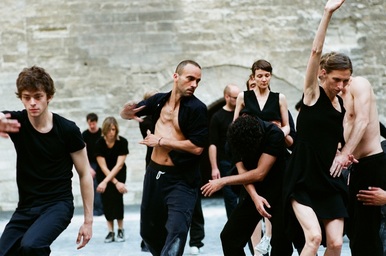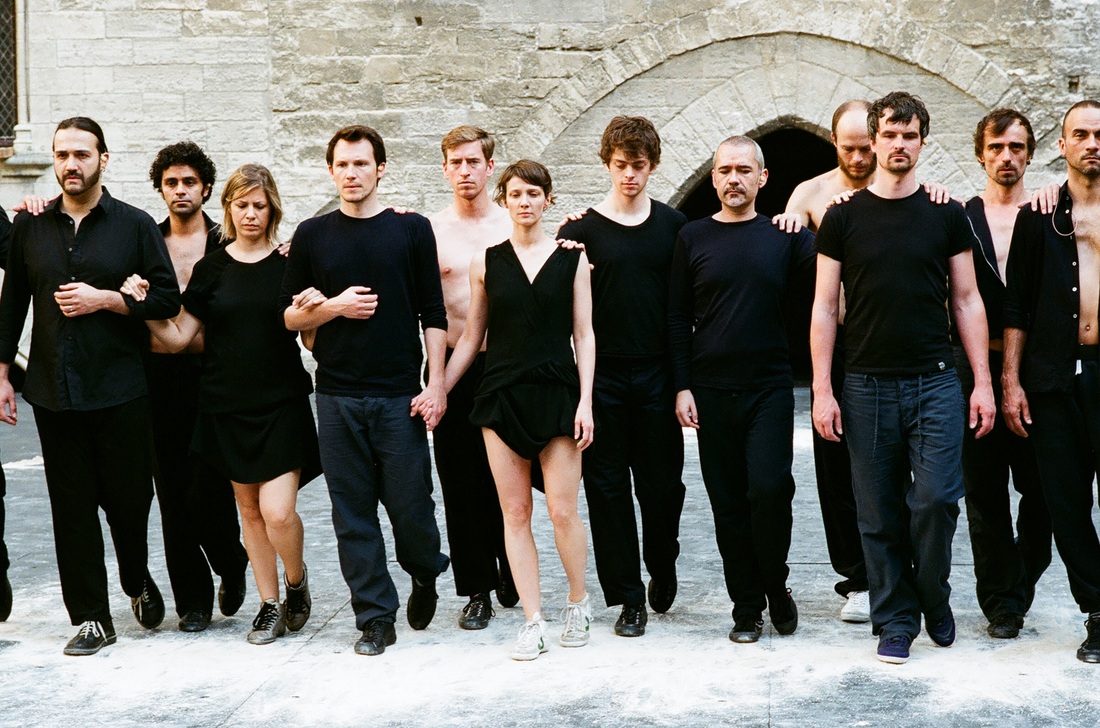|
My wish for the Montreal dance scene in 2013 is for Marie-Hélène Falcon to quit her job as artistic director of the Festival TransAmériques. I’m hoping she’ll become the director of a theatre so that the most memorable shows will be spread more evenly throughout the year instead of being all bunched up together in a few weeks at the end of spring. With that being said, here are the ten works that still resonated with me as 2012 came to an end. 1. Cesena, Anne Teresa De Keersmaeker + Björn Schmelzer (Festival TransAmériques)
I’ve been thinking about utopias a lot this year. I’ve come to the conclusion that – since one man’s utopia is another’s dystopia – they can only be small in nature: one person or, if one is lucky, maybe two. With Cesena, Belgian choreographer Anne Teresa De Keersmaeker showed me that it could be done with as many as nineteen people, if only for two hours, if only in a space as big as a stage. Dancers and singers all danced and sang, independently of their presupposed roles, and sacrificed the ego’s strive for perfection for something better: the beauty of being in all its humanly imperfect manifestations. They supported each other (even more spiritually than physically) when they needed to and allowed each other the space to be individuals when a soul needed to speak itself. 2. Sideways Rain, Guilherme Botelho (Festival TransAmériques) I often speak of full commitment to one’s artistic ambitions as extrapolated from a clear and precise concept carried out to its own end. Nowhere was this more visible this year than in Botelho’s Sideways Rain, a show for which fourteen dancers (most) always moved from stage left to stage right in a never-ending loop of forward motion. More than a mere exercise, the choreography veered into the metaphorical, highlighting both the perpetual motion and ephemeral nature of human life, without forgetting the trace it inevitably leaves behind, even in that which is most inanimate. More importantly, it left an unusual trace in the body of the audience too, making it hard to even walk after the show. 3. (M)IMOSA: Twenty Looks or Paris Is Burning at the Judson Church (M), Cecilia Bengolea + François Chaignaud + Trajal Harrell + Marlene Monteiro Freitas (Festival TransAmériques) By mixing post-modern dance with queer performance, the four choreographer-dancers of (M)IMOSA offered a show that refreshingly flipped the bird to the usual conventions of the theatre. Instead of demanding silence and attention, they left all the house lights on and would even walk in the aisles during the show, looking for their accessories between or underneath audience members. Swaying between all-eyes-on-me performance and dancing without even really trying, as if they were alone in their bedroom, they showed that sometimes the best way to dramatize the space is by rejecting the sanctity of theatre altogether. 4. Goodbye, Mélanie Demers (Festival TransAmériques) Every time I think about Demers’s Goodbye (and it’s quite often), it’s always in conjunction with David Lynch’s Inland Empire. The two have a different feel, for sure, but they also do something quite similar. In Inland Empire, at times, an actor will perform an emotional scene, and Lynch will then reveal a camera filming them, as if to say, “It’s just a movie.” Similarly, in Goodbye, dancer Jacques Poulin-Denis can very well say, “This is not the show,” it still doesn’t prevent the audience from experiencing affect. Both works show the triviality of the concept of suspension of disbelief, that art does not affect us in spite of its artificiality, but because of it. 5. The Parcel Project, Jody Hegel + Jana Jevtovic (Usine C) One of the most satisfying days of dance I’ve had all year came as a bit of a surprise. Five young choreographers presented the result of their work after but a few weeks of residencies at Usine C. I caught three of the four works, all more invigorating than some of the excessively polished shows that some choreographers spend years on. It showed how much Montreal needs a venue for choreographers to experiment rather than just offer them a window once their work has been anesthetically packaged. The most memorable for me remains Hegel & Jevtovic’s The Parcel Project, which began with a surprisingly dynamic and humorous 20-minute lecture. The second half was an improvised dance performance, set to an arbitrarily selected pop record, which ended when the album was over, 34 minutes later. It was as if John Cage had decided to do dance instead of music. Despite its explanatory opening lecture, The Parcel Project was as hermetic as it was fascinating. 6. Spin, Rebecca Halls (Tangente) Halls took her hoop dancing to such a degree that she exceeded the obsession of the whirling dervish that was included in the same program as her, and carried it out to its inevitable end: exhaustion. 7. Untitled Conscious Project, Andrew Tay (Usine C) Also part of the residencies at Usine C, Tay produced some of his most mature work to date, without ever sacrificing his playfulness. 8. 1001/train/flower/night, Sarah Chase (Agora de la danse) Always, forever, Sarah Chase, the most charming choreographer in Canada, finding the most unlikely links between performers. She manages to make her “I have to take three boats to get to the island where I live in BC” and her “my dance studio is the beach in front of my house” spirit emerge even in the middle of the city. 9. Dark Sea, Dorian Nuskind-Oder + Simon Grenier-Poirier (Wants & Needs Danse/Studio 303) Choreographer Nuskind-Oder and her partner-in-crime Grenier-Poirier always manage to create everyday magic with simple means, orchestrating works that are as lovely as they are visually arresting. 10. Hora, Ohad Naharin (Danse Danse) A modern décor. The legs of classical ballet and the upper body of post-modern dance, synthesized by the athletic bodies of the performers of Batsheva. These clear constraints were able to give a coherent shape to Hora, one of Naharin’s most abstract works to date. Scrooge Moment of the Year Kiss & Cry, Michèle Anne De Mey + Jaco Van Dormael (Usine C) Speaking of excessively polished shows… La Presse, CIBL, Nightlife, Le Devoir, and everyone else seemingly loved Kiss & Cry. Everyone except me. To me, it felt like a block of butter dipped in sugar, deep fried, and served with an excessive dose of table syrup; not so much sweet as nauseating. It proved that there’s no point in having great means if you have nothing great to say. Cinema quickly ruined itself as an art form; now it apparently set out to ruin dance too. And I’m telling you this so that, if Kiss & Cry left you feeling dead on the inside, you’ll know you’re not alone.
0 Comments
 Cesena, photo d'Anne Van Aerschot Cesena, photo d'Anne Van Aerschot L’impression que Cesena – le spectacle de près de deux heures da la chorégraphe belge Anne Teresa De Keersmaeker – laisse pourrait être traître. Je ne peux qu’y penser comme une utopie. Pourtant, si je m’efforce, je dois me rappeler que les premières 30-40 minutes sont exigeantes. Une seule lumière éclaire à peine la scène, de sorte que l’action est pratiquement invisible même lorsqu’elle est excessivement dynamique. Les interprètes sont alors moins corps que contours, moins physiques qu’audibles. La scène est parsemée de sable formant un large cercle et, typique pour De Keersmaeker, les pieds des interprètes trainent sur le sol. Pied contre sable, sable contre sol. Plancher sablé. Les interprètes ne volent pas, ne flottent pas. Leur danse est bien ancrée dans le poids indéniable du corps qui les humanise. Ils sont dix-neuf en tout, certains danseurs, certains chanteurs, sans toujours qu’on puisse les différencier, même si on peut souvent le deviner. C’est que tous les interprètes s’adonnent autant à la danse qu’au chant. Pour cette dernière, on retourne au quatorzième siècle avec l’ars subtilior, ici dirigé par Björn Schmelzer. Le peu que l’on aperçoit nous laisse déjà entrevoir la communauté. Les mains des uns reposent sur les épaules des autres alors qu’ils se déplacent à l’unisson. Une note, un pas. Silence, immobilité. La danse et le chant deviennent indissociables. Après tout, ils émanent tous deux du mouvement. Et une deuxième lumière. Ce n’est qu’à ce moment qu’on découvre le genre, qui se trouve être hors du commun pour un spectacle de danse contemporaine. Seize hommes et seulement trois femmes. Et une troisième lumière. J’ai parlé d’utopie parce qu’il y a ici une parfaite balance entre la communauté et l’individu. Les interprètes se supportent, souvent plus moralement que physiquement, mais aussi s’effacent vers les côtés de la scène lorsqu’ils doivent laisser de la place aux individus qui se démènent dans l’extase. On retrouve aussi cette dualité dans les costumes. Leurs chandails, pantalons et robes sont tous foncés, clairement le fruit d’une coordination esthétique. Par contre, aux pieds, on devine de par l’éclectisme coloré qu’on y trouve que chacun porte ses espadrilles préférées. Vers la fin du spectacle, certains échangeront leur sombre chandail pour un plus coloré. Je parle aussi d’utopie à cause de l’effacement des rôles prédéterminés qui permet à tous les interprètes de s’adonner à la danse et au chant. Oui, on peut deviner que certains sont plus danseur que chanteur (et vice versa), mais ce n’est pas perçu comme étant « meilleur » ou « pire. » Ce sont tout simplement différentes qualités de mouvement et de voix qui émergent. Ils sont tous beaux. Cesena 1-2 juin à 20h Théâtre Maisonneuve www.fta.qc.ca 514.844.3822 / 1.866.984.3822 Billets à partir de 35$ |
Sylvain Verstricht
has an MA in Film Studies and works in contemporary dance. His fiction has appeared in Headlight Anthology, Cactus Heart, and Birkensnake. s.verstricht [at] gmail [dot] com Categories
All
|

 RSS Feed
RSS Feed